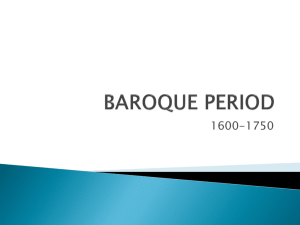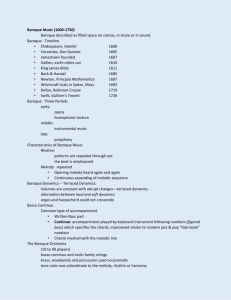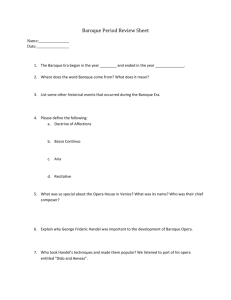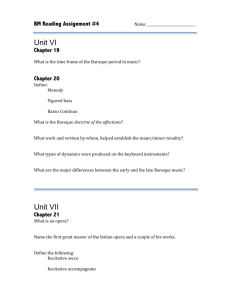Part III PowerPoint Complete
advertisement
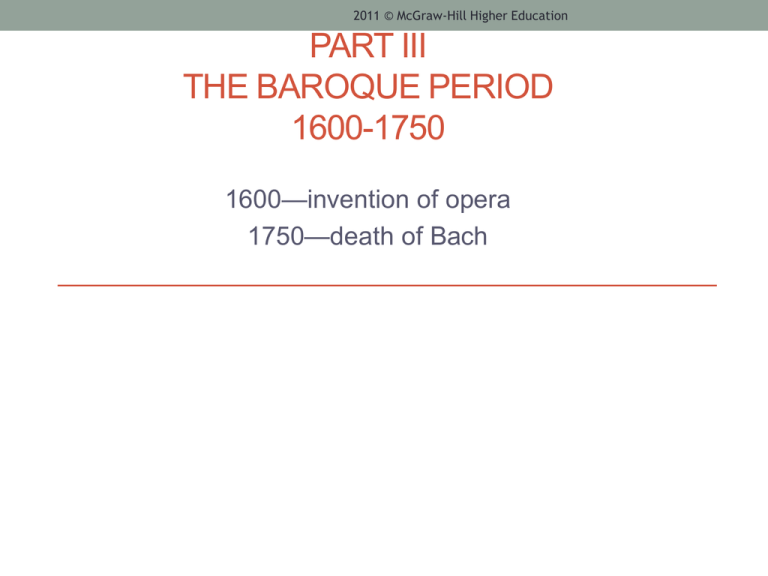
2011 © McGraw-Hill Higher Education PART III THE BAROQUE PERIOD 1600-1750 1600—invention of opera 1750—death of Bach Traits of Baroque • Evocation of emotion (early baroque) • Music textually oriented • Compare: As Vesta Was Descending/Dido’s Lament The Baroque Style • “Baroque” used early on a pejorative • Overly ornamented, flamboyant • Baroque style “fills the space” • Visual Art • Implies motion • Busy • Architecture • Elaborate • Change in approach to science • Age of Rationalism—God as watchmaker • Inventions and improvements result Pieter Paul Rubens Deposition from the cross Baroque Architecture • Saint Yves at La Sapienza--Rome 1660 by Francesco Borromini Music in Baroque Society • Age of absolute monarch • Arts shaped by aristocratic tastes • New music written to order! • Role of musicians: servant • Court Music Director: a good, but demanding job! • Some aristocrats were musicians Particularly in early Baroque • Church music was very elaborate • Most people heard music only in church • Some, though few, public opera houses • Music careers taught by apprenticeship • Orphanages taught music as a trade Music in Society • Simultaneous rise of middle class • Composers also wrote for Church, aristocracy and public, particularly for opera • Role of women: professional composers existed • Barbara Strozzi, Francesca Caccini are famous examples Venice! • Venice becomes a musical capitol • SIX opera houses • Increasing need for “town” musicians Ch. 1 - Baroque Music • Two giants of Baroque composition • Johann Sebastian Bach (period ends w/ Bach’s death) • George Frideric Handel • Other noted composers • • • • Claudio Monteverdi Henry Purcell Arcangelo Corelli Antonio Vivaldi Period divided into three phases Early: 1600-1640: favored homophonic texture • The third long since considered consonant, chords built upon it • Dissonance becomes a tool to convey drama Middle: 1640-1680: major & minor scales dominate Late: 1680-1750: dominant chord to the tonic • Return of polyphony Rise of instrumental, non-dance music • No longer reliant on voice to convey interest or emotion • Whole sets of musical conventions arose to convey emotion through music • Argued that only one affect could be effectively projected in a piece • The Affections—a treatise on harmony • Goes far beyond major and minor scales Characteristics of Baroque Music • Unity of Mood • Expresses one mood throughout piece • Rhythm • Rhythmic patterns are repeated throughout • Provides compelling drive & energy • Melody • Opening melody heard again and again • Continuous expanding of melodic sequence • Dynamics • Volumes are constant with abrupt changes – terraced dynamics Terraced Dynamics mf mp mp Example: Bach, Brandenberg concerto No.5, 3rd movement. • How is “unity” expressed in • Melody • Rhythm • Mood • Dynamics? The Orchestra • Compare to Renaissance: consorts, chests of instruments • Composers did not specify parts • No distinction between vocal, instrumental part (with exception of lute song) • Baroque orchestra: violin family • Small by modern standards • Composers wrote for specific parts—instrumentation could vary— strings, brass, woodwinds, percussion • Specific instrument might be highlighted • Flute, oboe, etc • Tone color subordinate to melody • At its core: the basso continuo Characteristics of Baroque Music • Chords and the Basso Continuo • Chords meshed with the melodic line • Bass part served as foundation of the harmony • Basso Continuo: accompaniment played by keyboard instrument following numbers which specifies the chords – similar to modern jazz & pop “fake book” notation Basso Continuo, figured bass Baroque Forms • Instrumental music frequently made up of movements Movement: a piece that sounds complete in itself, but is part of a larger composition • Performed with pause between movements • Unity of mood within individual movements • Movements often contrast with each other • Common basic forms: • Ternary • ABA • Binary • AB • AAB • ABB • AABB Ch. 3 - The Concerto Grosso and Ritornello Form Concerto Grosso • For small group of soloists and orchestra • Multi-movement work • Usually 3 movements • • • • Fast Slow (usually quieter) Fast (sometimes dance-like) First and last movements usually in ritornello form Ritornello: a refrain form based on alternation between the tutti and soloists (concertina) • ritornello is the home base–very common form Ritornello Form: by definition, polyphonic • Frequently used in 1st & last movements of concerto grosso • Theme repeatedly presented in fragments • Contrast between solo sections and tutti The Brandenberg Concerti (plural of concerto) • 1721 • Cȍthen period (1717-23) • Prince Leopold—musician, supported Bach well until his (the prince) marriage in 1721…. • Bach stayed until 1723, but wrote the Margrave of Brandenberg, and accompanied the letter with all six concerti! Highlights of No. 5 • First time harpsichord used as soloist in concerto • New harpsichord—Bach wanted to show it off, as well as his own talents • Remarkable solo! • Six Brandenberg concerti—all remarkable pieces of music—a great start to a record collection Listening Brandenberg Concerto No. 5 in D major by Johann Sebastian Bach For string orchestra and group of soloists Soloists: flute, violin, and harpsichord First movement Ritornello form Listening Outline: p. 110 Listening Log: Brandenberg Concerto #5, first movement • Create a 10 min timeline across the page • Use the letter R for ritornello, S for solo, H for harpsichord (or create your own graphic representation for each section • Change symbol as each section arises • During harpsichord solo, try to notice if material is derived from ritornello or solo • Notice the dynamics – how do they contrast in each section? Ch. 4 - The Fugue • Cornerstone of Baroque music • Very high art form, still used today • Polyphonic composition based on one main theme (monothematic) • Vocal or instrumental • Subject: Main theme • Presented initially in imitation—multiple “voices” • Each voice enters after previous voice has completed presenting the subject • Subject followed by Countersubject— varies in rhythm and melody Fugue Exposition—entrance of all the voices Episodes: areas of free counterpoint Episodes use materials of the subject and countersubject • Fragments of each melody may appear • Subject and countersubject will appear at various times to interrupt episodes “Tools” of the fugue: all used within very strict composition rules Inversion—turning theme upside down Retrograde—playing it backwards Retrograde inversion—backwards and upside down “Tools” of the fugue • Diminution—theme presented in faster rhythms while tempo remains stable • Augmentation—theme presented in slower rhythms while tempo remains stable • http://www.mhhe.com/socscience/music/kamien/student/o lc/45.htm 18 Subject in alto, countersubject in running notes in soprano. The answer, in dominant key Listening Organ Fugue in G Minor by J. S. Bach Chapter 5: Opera • The ultimate art form • Fuses music, acting, poetry, dance, scenery, costumes into single production! • Began in Italy in 1600 • Many non-western forms of musical drama predate opera • Outlandish plots! • Emotional intensity! • Sometimes mythical figures • Social function? Ch. 5 - The Elements of Opera • Drama sung to orchestral accompaniment • Text in opera is called libretto • Music is written by a composer • Libretto is written by a librettist • Opera can be serious, comic, or both • Two primary types of solo songs: • Recitative: presents plot material • Aria: expresses emotion—usually a “show-off” vehicle for the singer • Other types: duet, trio, quartet, quintet, etc. • Three or more singers make up an ensemble • Chorus: groups of actors playing crowd parts • The prompter—gives cues to singers • The orchestra pit – sunken area in front of stage • Prelude or overture - instrumentals that open opera acts • Modern questions concerning text in opera • Translation of text and effects upon text painting • Supertitles-projection of text above the stage Ch. 6 - Opera in the Baroque Era Result of musical discussions of the Camerata in Florence Wanted a revival of Greek dramas Were convinced that Greek dramas were sung Existing madrigals were Unsuitable – why? The Florentine camerata Early Opera • 1st known opera: Euridice (Peri-1600) Orfeo (Monteverdi-1607) • 1st large scale (great) opera • Opera composed for court ceremonies • Display of magnificence and grandeur • Patrons compared to ancient heroes • 1st public opera house 1637 in Venice • Rise of virtuoso singer • Secco vs accompanied recitative Ch. 7 - Claudio Monteverdi (1567-1643) • Italian, early Baroque composer • Wrote first great operatic work, Orfeo • Worked last 30 years at St. Mark’s in Venice • Composed both sacred music and secular music for the aristocracy • Wrote secular and sacred music _ madrigals, opera, Only 3 of his 12 operas still exist Listening Tu se’ morta from Orfeo by Monteverdi Note: Homophonic texture Use of text painting Vocal Music Guide: p. 122 Listening Log 1 Tu se’ morta from Orfeo by Monteverdi 1. List the word painting devices Monteverdi uses as you hear them. 2. Comment on the emotional impact that is conveyed beyond the “action” Tu se’ morta sé o da sepiù me ciò partita negherammi per empio più, destino, rimarrò You Or, have ifno, pitiless left me forevermore, denies me this, Isun, will remain Tu sé morta, sé morta, mia vita, dead, dead, life, ed e, n'andrò mai no, mecco Addio intenerito io no, respiro; sicuro non terra, trarrotti che iltornare, se tu cor addio a'sé ia più versi del riveder damai cielo, profondi re ed me alcuna de io partita, le erimango-l'ombre, sole, stelle, cosa abissi, addio. ponno, And, Will having bring And IYou Never will No, melted Farewell you Iare go breathe; toconfidently back ifthe return, my earth, heart tofate you verses me and farewell have of to tomy Ithe the have see remain-left king deepest sky, the any me, of stars and power, shadows, abysses, again, farewell. teco in compagnia di morte. with you in the company of death. The Aria • Invented CA 1660 as concept of “tune” develops What is an aria about? Emotion Its qualities: • A “song” as we know it today • Nearly always accompanied by orchestra • if stanzas repeated, called Da Capo • High melodic profile Ch. 8 - Henry Purcell • English composer (1659-1695) • Highly regarded, held court positions • Buried beneath the organ in Westminster Abbey Listening: Dido’s Lament from Dido and Aeneas by Purcell Ground Bass • Repeated musical idea in bass • Variation form— melodies above change • Also called basso ostinato Note: Recitative followed by da capo aria Aria makes use of ground bass Listening Log 2 • Create a timeline of 4 minutes, marked at 15 second intervals • Using our emotional seismograph, show the emotional intensity during the performance • Describe what musical elements are responsible for this intensity. Consider: • Harmony (the ground bass, for instance, or dissonance) • The pitch • The dynamic range of the singer • The lyrics Ch. 9 - The Baroque Sonata •Instrumental work • Multi-movement piece for 1 -8 instruments • Trio sonata • Three melodic lines: basso continuo and two above • Written as three parts, but performed by four players Sonata da chiesa—church sonata (dignified) Sonata du camera—chamber sonata (more dance-like, intended for court performance) Listening Log 3: Trio Sonata in A Minor By Arcangelo Correli • We will listen to all four movements of this sonata • Write a timeline, approximately 4 min. • For each theme, create a graphic representation of melody and rhythm--listen for melodic contour, tempo, texture, • Based on this representation, does each movement maintain unity within itself? • How does Corelli create contrast between each of the movements? List elements of each • Tempo • Texture • Melody/rhythm Trio Sonata in A Minor, Op. 3, No. 10 (1689) by Arcangelo Corelli For 2 violins and basso continuo (three parts, four instruments) Ch. 10 - Antonio Vivaldi • Late Baroque Italian composer • Il prete rosso (the red priest) • Taught music at girls orphanage in Venice • Girls performed at mass hidden behind screen • Wrote sacred and secular vocal and instrumental music • Famous as a virtuoso violinist & composer Listening La Primavera (Spring), Op. 8, No. 1, from The Four Seasons (1725) by Vivaldi Listening Outline: p. 128 Basic Set, CD 2:25 Brief Set, CD 2:12 Concerto for violin and string orchestra Note: Polyphonic texture & ritornello form Baroque program music Descriptive effects (trills for bird songs, tremolos for thunder) string Listening Log 4: La Primavera (Spring), Op. 8, No. 1, first movement • Create a symbol for tutti (ritornello), and another for solo (X, O, etc) • Make a 4 minute timeline, marked at 15 second intervals • As each section arrives, mark the proper symbol • As Programmatic elements arrive, show in score— thunder, etc. Hint they can be in both tutti and solo. • Total the number of ritornello entrances • Instrumentation: violin (solo), strings, harpsichord (basso continuo) • CD 1, Tracks 63-67, Duration 3:15 • 63) Spring has come • • • • • The first phrase of the ritornello is presented by the string orchestra (tutti). :23 Closing phrase in a syncopated rhythm. 64) Song of the birds This first solo section consists of a solo violin with two supporting violins. Bird songs are imitated with trills in the high register and repeated notes. :33 Return of tutti with second phrase of ritornello. 65) Murmuring streams Flowing water is represented by running passages in the violins and cellos. :23 Return of tutti with second phrase of ritornello. 66) Thunder and lightning String tremolos and rapidly moving ascending scales introduce the solo violin. :26 Return of tutti with second phrase of ritornello (in minor). 67) Song of the birds Solo violin with two supporting violins. Bird songs are imitated with trills in the high register and repeated notes (in minor key). :17 Tutti, with variation of opening phrase which ends in a major key. :27 Running passages in solo violin accompanied by the continuo (harpsichord). :41 Closing phrase of ritornello is presented by the tutti in a major key. Ch. 11 - Johann Sebastian Bach: Greatest Western composer ever? • Organist and violinist • Deeply religious (Lutheran) • I.N.J/J.J? • Worked in sacred and secular positions • Weimar/Cothen/Leipzig • Known during lifetime as keyboardist – not so much as a composer • Wrote in every form except opera Ch. 12 - The Baroque Suite An Instrumental, multi-movement work • Written for listening, but based upon dance • Movements usually in binary form—AABB • Often began with a non-dance overture • Generally homophonic – with many exceptions • Forerunner of forms used in the next period The Suite—International by design • Non-dance movement, followed by several dance • • • • • • movements Courante: fast triple meter (France) Gavotte: moderate duple (France) Allemande: moderate duple (German) Sarabande: slow triple (Mexico) Bouree: fast duple (France) Gigue: fast triple (England, Irleland) Listening Suite No. 3 in D Major (~1730) by J. S. Bach, 4thmovement Listening Outline p. 135 Note:Extensive polyphony Contrast of dance forms and tempo in various movements The Chorale and Church Cantata • Two types of religious dramatic music • 1. The cantata: One act (though multiple movement) religious opera, part of religious service • 2. The oratorio: complete opera on religious topic, not part of service Ch. 13 - The Chorale and Church Cantata • Lutheran church service was social event of the week • Lasted 4 hours with 1 hour sermon • Music was major part of worship service • Congregation participated in singing chorales • Chorale: hymn tune w/ German text • Melodies often known by congregation • Cantata • Multi-movement church work for chorus, soloists, and orchestra • Vernacular religious text • Resembled opera in its use of choruses, recitatives, arias, and duets How Cantatas were written: • Pastor tells composer the theme of the week’s sermon—based on religious calendar • Bach selects chorale melody, sets text to that melody (in case of Wachet Auf, the chorale is preexisting • Uses this melody as the basis for many of the cantata’s movements • Intersperses recitative, instrumental movements; all vocal movements revolve around the week’s sermon Wachet auf, ruft uns die Stimme (Awake, A Voice Is Calling Us) The Parable of the wise and foolish virgins, from the New Testament • What are the symbols involved? The cantata is scored for • three soloists—soprano, tenor and bass • a four-part choir • horn, 2 oboes, taille--today often replaced by an English horn, violino piccolo, two violins, viola, and basso continuo. Seven Movements: 1. Coro: Wachet auf, ruft uns die Stimme (Wake up, the voice calls to us) 2. Recitativo (tenor): Er kommt (He comes) 3. Aria (soprano, bass): Wenn kömmst du, mein Heil? (When will you come, my salvation?) 4. Chorale (tenor): Zion hört die Wächter singen (Zion hears the watchmen singing) 5. Recitativo: So geh herein zu mir (So come in with me) 6. Aria (soprano, bass): Mein Freund ist mein! (My friend is mine!) 7. Chorale: Gloria sei dir gesungen (May Gloria be sung to you) Listening Wachet auf, ruft uns die Stimme (Awake, A Voice Is Calling Us) by J. S. Bach (1731), Movements 4 & 7 Vocal Music Guide: pp. 140-141 Note: Vernacular (German) text Chorale tune basis Polyphonic until chorale in movement 7 Movement 7—provides for congregation to join in Movement 7: - Chorale melody set to SATB - homophonic Chorale: Gloria sei dir gesungen (May Gloria be sung to you) Wachet auf, ruft uns die Stimme 1st movement: Ritornello form Listening Log: Wachet Auf • Create a timeline of six minutes, marked at 15 second intervals • Mark each new phrase of the chorale melody by drawing a wavy line over the timeline for the duration of each occurrence Ch. 14 - The Oratorio • Like opera: • History of liturgical drama, the sacred dialogs • Large-scale work for chorus, soloists, and orchestra • Contains arias, recitatives, ensembles • Unlike opera: • No acting, scenery, or costumes • Based upon biblical stories • Not intended for religious services • Commonly performed today in both churches and concert halls Ch. 15 - George Frederic Handel • Born in Germany—same year as Bach • Not from musical family • Father wanted him to be a lawyer • Studied music in Germany, then to Italy to study opera, finally England to work • Became England’s most important composer • Wrote many operas in London • Had own opera company • Worked as composer, performer, & impresario • Buried in Westminster Abbey Messiah • Part 1: Prophecy of Christ’s birth • Part 2: “the accomplishment of redemption by the sacrifice of Jesus, mankind’s rejection of god’s offer and mankind’s utter defeat when trying to oppose the power of the Almighty.” • Part 3: faith in the certainty of eternal life thorough Christ as redeemer Listening Log: From Messiah by G. F. Handel (1741) Ev’ry Valley Shall Be Exalted: Vocal Music Guide: p. 143 List the word painting devices as they occur Messiah, cont. Hallelujah Chorus Vocal Music Guide: p. 146 Basic Set, CD 3:09 Brief Set, CD 2:28
